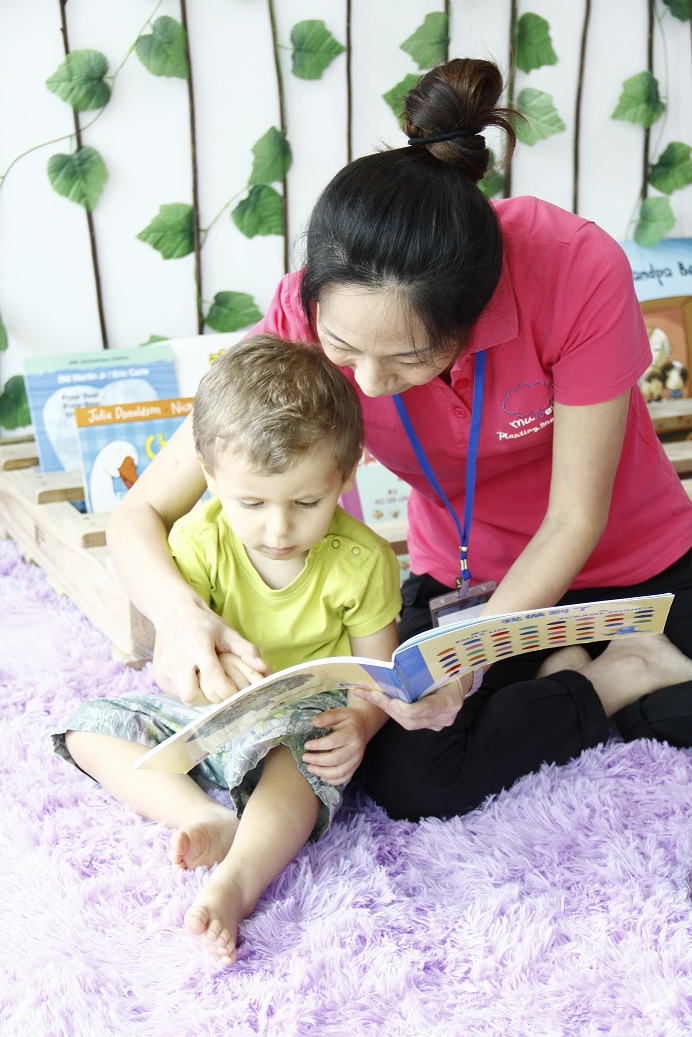Tips on dealing with tantrums and meltdowns
All children, no matter how angelic, will eventually have a one – or many – horrific meltdown or temper tantrum. And though it might be tempting to just “abandon ship” and leave them where they cry, our innate parental responsibility still leaves us desperate to find the best way to understand, pacify and help them work through their emotions.
Rest assured, having your kid wail, kick and cry and scream doesn’t mean you fail at being a parent. There’s no single correct way to discipline a child and it’s normal to not know the best way to keep them well-behaved all the time. To help you navigate through the tough times of the “terrible twos” and toddler tantrums, we’ve interviewed 5 teachers from Mulberry Learning to get these tips on how to best deal with meltdowns.
1. Talk to your child at eye-level and reward them with praises for positive behaviour

It can be hard to hold on to the attention of an angry, crying child, but Teacher Logesh from Mulberry Learning shares that one sure way of getting the message across in a gentle yet firm manner is by lowering yourself to their level – literally – and maintaining good eye contact.
Not only will this remove the authoritative invisible barrier your child might be feeling, it’ll make him or her feel safer and more willing to open up in terms of what they’re going through. On top of this, be sure to praise your little one generously when good behaviour is observed! Positive reinforcement is always a good way to stave off a meltdown.
2. Distract your wailing child by starting a new activity

The short attention span of a child can be frustrating especially when you’re trying to get them to listen to you or to complete a task. But here’s a pro tip from Teacher Xu from Mulberry Learning: utilise this to your advantage – that also means you can stop the crying with a little distraction tactic. The next time you are faced with a wailing child, try initiating a new activity in place of something they can’t do or have.
For example, if they demand an unreasonably expensive toy you don’t want to spend money on, try changing the topic to getting chocolate ice cream later, or talk about catching a new movie over the weekend.
3. Make sure your child gets enough sleep
Every parent knows that a disrupted nap or sleepless night could spell hours of mindless screaming and wailing – kids have a mind-boggling ability to shriek endlessly, it’ll tire you out before they even show any signs of stopping.
According to Teacher Colleen from Mulberry Learning, parents should be mindful of nap and bedtimes, and stick to a fixed routine of afternoon nap times as much as possible – so you can plan your schedule around your child and run errands easily. Something that isn’t as easy when your toddler is irritable and whiny.

Image credit: @drstephanieyoungming
In her years as a preschool teacher, Colleen has witnessed toddlers get hyper, extremely difficult and act out all in the name of poor sleep. It may be a good idea to train them to nap on the go in a stroller or a baby carrier from a young age, this will help reduce the limitations of naps and bedtimes.
4. Take them aside to a quiet, safe space to calm down
It can be embarrassing to have your child kick and scream in public and you may want to just settle them ASAP by giving in to them and pacifying them with whatever you have. Teacher Ria from Mulberry Learning explains that it is good to first determine the nature of the meltdown to help you quickly get to the source.

Image credit: Mulberry Learning
She adds that sensory meltdowns happen when your child is overwhelmed by the environment they’re in and moving them into a quiet space will help them calm down. If it’s an anger-induced tantrum, then you’ll need to first keep calm and understand that what your child is feeling is valid.
Logical reasoning and impulse control is something toddlers are still in the progress of developing and these meltdowns are all part and parcel of growing up. Here are some recommended steps to calm the child down:
- lead him/her to a quiet space
- ensure that your child isn’t in a position to inflict self-harm or put anyone else in harm’s way
- maintain a firm but calm disposition and wait it out
Tip: If it’s a tantrum over an item they want but can’t have, it’s also a good idea to keep that object out of sight. In cases of attention-seeking tantrums, ignoring your child’s behaviour is the way to go.
5. Give them more responsibility in their day-to-day life

Dealing with tantrums and meltdowns when they happen is one thing, but working to minimise the frequency of it is another thing you might want to start looking into. One way to do is to empower your child by giving him/her the ability to make small choices for himself/herself.
It could be as letting them choose between orange and apple juice or tasking them with small duties around the house to allow them to feel a sense of independence and control over their environment.
By giving them a little bit of authority, they can also learn to make choices and be more independent. In this way, tantrums can also be reduced when they feel satisfied with being able to make choices for themselves.
Handling difficult children with tips from Mulberry Learning teachers
Children can be angels in a moment and terrors in the next – we never know when we might have to deal with a meltdown. Even the best-behaved child can whine and make unreasonable demands sometimes – and that’s when we need to learn how to calmly deal with the situation. With advice from these teachers at Mulberry Learning, we can learn how to handle the challenges in parenting and even grow together with our kiddos.
In addition, the curriculum at Mulberry Learning is also a rather unique one because it features the Habits of Mind™ framework that’s also adopted by the Ministry of Education in its Gifted Education Programme. This famed methodology introduces 16 good habits to children at a young age to help them manage their impulsivities, handle emotions better and acquire critical problem-solving skills.
Together with the Reggio Emilia approach, you can rest assured that your child will be able to grow holistically and acquire the relevant future-ready skill sets required for success in the world. You can read about our experience undergoing a day at one of their campuses here.
Find out more about Habits of Mind and Mulberry Learning here
Also read these articles on things to do with kids:
- Things to do with kids in Singapore
- Guide to having a baby in Singapore
- Must-have items for travelling with kids
- Free playgrounds in Singapore malls
- Kidztopia Marina Square
This post was brought to you by Mulberry Learning.